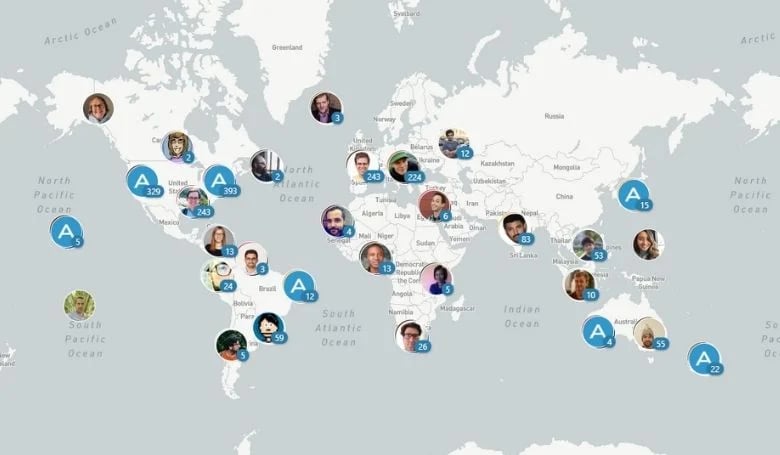Over the past thirty years, the growth of the Internet and online systems has led to new ways of organizing and structuring businesses.
These days, it can make little difference where an organization's staff are physically located. The difficulties and time lost during commuting, the global pandemic, and other factors, have shown organizations that they can carry on pretty much as before, without having to house all their personnel under one roof in traditional workspaces.
Some companies (as we shall discuss) have always 'operated virtually', and drawn great benefits from doing so, scaling fast into global organizations.
Post pandemic, it could be that we never go back to a situation where city-dwelling office workers all commute at the same time of the day, back and forth to work, every working day.
What is a Virtual Organization?
In a virtual organization, employees are physically located anywhere in the world, and connected through online apps and systems such as Slack, Asana and Zoom.
Being located around the world, in different time zones, means global companies can provide services 24 hours a day to whoever they want.
The virtual organization still 'exists', has structures, departments and systems, much like any other organization.
In some senses, they may not physically exist “but are made by software to appear to do so"(1). They have been described as "unreal but made to look real". (2)
Types of Virtual Organization
A virtual organization can also be a flexible network of separate, collaborative entities and people that come together to deliver a product or service.
This arrangement could be temporary, or refer to one part of the overall organization, or be a permanent structure.
There are various types and approaches:
- Mobile Working: employees are 'mobile', meaning they can work from anywhere using mobile devices such as smartphones and laptops. Field service personnel and salespeople often work in this manner.
- Virtual Teams: employees of one organization may work with employees from another organization. The combined 'virtual' team works together using email, apps and video conferencing from geographically dispersed locations.
- Telecommuting: here staff work from a place other than the normal workplace, such as from home. This activity increased dramatically during the Covid pandemic.
- Hot Desking: staff can work in a physical space, or from home, and can come in and use fixed desks as they wish. Signing into a workstation automatically pulls up their preferences and software, so they can work on any station.
- Telecentres: spaces for employees that require specialized systems not normally available in their own home. Used mainly for rural staff.
Automattic (Wordpress), Virtual Organization
Automattic, the company behind Wordpress, which powers 20% of all websites on the planet, runs a virtual organization of 1,850 people speaking 119 different languages, in 96 countries.
According to their ‘About Us’ page (3), Automattic deploys 400+ web changes in a typical week, sends 662,000 Slack messages and interacts with 26,000 clients.
Founded in 2005, the company’s mantra is “help make the web a better place" and its staff can "work wherever [they] like and take as much leave as [they] want.”
Founder Matt Mullenweg prefers the word ‘distributed’ to ‘remote’ when describing his organization. He even has a podcast called ‘Distributed’ where he discusses the future of work. (4)
His idea is that the workforce should not feel remote, they are merely distributed around the world.
1,850+ Automattic Staff, around the world

Source: https://automattic.com/map
Looking through some of their employees' details, you can see 'Code Wranglers' located in Thailand, 'Rocket Engineers' in Portugal, and even a 'Protector of the Asynchronicity' in Salt Lake City.
A converted warehouse acts as their head office, located in San Francisco, California, but otherwise, Mullenweg has grown the business without needing physical office space.

(Above and Below:) Automattic's simple head office, 29th Street #343, San Francisco, CA 94110

In September 2019 Automattic raised US$300 million from Salesforce Ventures, valuing the company at US$3 billion.
How Virtual Organization Zapier Grew from 3 to 550 people
Nike, Dell Computers, GitLab and Zapier are other proponents of the virtual organizational structure.
Zapier's view is "if you are on Slack, you're at work." Over the past ten years, the organization has grown from three co-founders to more than 550 people, in 38 countries.
The central concept is to automate the use of web applications, with the idea springing from a Startup Weekend in Columbia, Missouri, in 2011.
From the outset, the three co-founders all worked in different cities developing Zapier as a side hustle along with their own day jobs. They were virtual from the start, and have retained this structure since.
In 2012, they were accepted onto the Y-combinator accelerator. This three-month period was the only time they worked in the same city at the same time.
By the end of 2012, they started hiring, with a head of support in Chicago, and eight more people living and working from Nebraska, Missouri, Pennsylvania, Florida, and Tennessee. By 2014, they had their first international hires, in Thailand and the UK.
"Over the years, we've learned a few things about building and managing remote teams," said co-founder and CEO Wade Foster.
"Our story—and the stories of other remote companies - proves that it's possible to scale even when you're fully remote."
Foster's three tips for scaling a remote team are:
- Team - hire doers, "people you can trust, and then trust the people you hire."
- Software and Tools - use a platform, such as Slack, as your virtual office; this builds camaraderie that may be lost when not physically located together. Use good systems and interactive wikis that help bring new staff up to speed quickly, wherever they are.
- Processes - use a buddy system, weekly one on ones, hangouts, automate what can be automated, and build the right culture into every person.
Both Zapier and Automattic show how you can build sizeable and successful organizations, virtually.
Pros and Cons
Virtual organizations are not for everyone, and come with various advantages and disadvantages.
Potential Benefits of the Virtual Organization
- More cost-efficient, less need for physical office spaces
- Broader employee pool to select from, rather than from the 'commuting distance'
- Greater degree of flexibility, dynamism and responsiveness
- Research has shown a 30 to 50% rise in productivity (5)
- More independence for employees
- Less stress and workplace pressure, improved personal and family life
- Less time and money spent commuting
- Possibility to work efficiently even from remote, rural areas
Possible Drawbacks of the Virtual Organization
- Can be challenging to lead
- Difficult to retain a strong culture
- Language and time barriers
- Removal from the workplace can create loneliness on the job
- Less interpersonal collaboration
- High degree of investment in technological costs
- Employees don't separate work from home life, leading to burnout
 : Let Functionly help you organize your Team
: Let Functionly help you organize your Team
While Automattic and Zapier provide great examples of how to scale an organization in a virtual and real sense, many companies have tried and failed to do so. In fact, once most organizations grow beyond 25 or 30 staff, the 'system' tends to take over, and the organizations can 'break'.
This is why we developed Functionly's easy-to-use, drag-and-drop online tools. They are immensely powerful, and fundamental for your organization's success. Getting the structure right to meet your organizational strategy is critical.
Whether you organize your virtual company within functional departments, or as a matrix, or flat or bottom-up, Functionly is here to help.
Sign up for free today, and get started with Functionly.
~~
Sources
- Oxford University Press definition, 2014.
- e-Business strategies for Virtual Organizations, J Burn, M. Barnett and P. Marshall, Oxford: Taylor & Francis Ltd, 2002
- Autommatic.com/About
- ‘Distributed’ podcast, with Matt Mullenberg, wherever you get your podcasts
- How to Manage a Remote Team, W. Foster, Zapier, 18 Mar 2020
- Understanding Virtual Organizations, Isaca, 2001
- Types of Virtual Organization, Geeks for Geeks, 8 Jan 2020
- Trust and the Virtual Organization, C. Handy, HBR, May-June 1995




